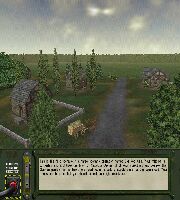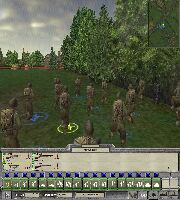Peace sells, but who’s buying? Not KenShima, he’s reviewing G.I. Combat, a new WWII RTS game.
Developed by: Freedom Games
Published by: Strategy First
INTRODUCTION
Normandy, June 1944. The clouds hoved over the horizon as soldiers crept onto the wet sands of Omaha beach. Weeks of torturous battles lay ahead of them – the chance to wage war for their country, battle for their futures and strive for victory! – from the back cover.
GI Combat, Episode 1: Battle of Normandy (GIC1) is a real time strategy (RTS) game which is basically a 3d version of Close Combat. And its no wonder. The designers of GI Combat are the same guys who created Close Combat.
This title is geared towards the strategy fan and the WWII buff.
GIC1 takes place after the D-Day invasion. Players decide if they wish to go thru a single scenario, an operation, or a full campaign. I enjoyed being able to join in the operations made famouse by the Big Red One (US First Infantry Division) and the Screaming Eagles (US 101st Airborne Division).
Players control squads of men instead of controlling every individual soldier. Surviving squad members gain experience and stronger morale as they get promotions and medals for their service. A squad’s morale may even cause them to retreat and run for their lives when senior soldiers and officers get killed.
Squad types are very similiar to what the was used in World War II. American rifle squads compose of men using Garand rifles while German rifle squads used the Mauser. Heavy support teams may use the .30 caliber or .50 caliber machine gun while armor may comprise of the Sherman or Panzer tank.
GAMEPLAY
Before combat begins, the scenario briefing tells you what the goal of the mission is. In most scenarios there are flags that worth a certain number of points that have to be captured by a certain time limit. This time limit varies and can be controlled by the player.
Another way to win is to kill all the opposition, depending on the scenario and whether or not you play the US or German forces.
Unlike other RTS games, there are no structures to build. Each scenario starts with a basic set of units that a player is given. Then based on the complexity of the scenario, there are a set of resource points a player is given in order to purchase more units. There are only a limited number of points so not all the extra units can not be purchased.
For example, a player may start with 6 rifle squads, 2 heavy rifle squads, and 1 platoon command squad. Then there could be an selection of 2 tanks, 2 mortar squads, 2 flamethrower squads, and 2 machine gun squads.
After the squad selection is given, the layout of the battlefield is given. Then player deploy their troops onto the field and gives them their first orders: defend, march, fire at a target, provide smoke cover, or assault a target. Then the click a START button and combat begins.
This is when GIC1 begins to show the accuracy and realism put into the title.
Just like a real battlefield, things tend to go crazy after the first shot. Plans begin to change as your troops come under fire. Giving orders to your forces doesn’t mean they will follow command.
Icons at the bottom of the screen represent the morale and strength of the squad. By clicking on the icons, the list of the men within the squad is displayed. This list shows their strength, weapon type, and how much ammunition they have left.
A squad that has taken several losses, or loses it’s officer, will often lose their morale points and break ranks to retreat to a safe spot on the field. This is known as “breaking.”
If they are commanded to move forward, the squad will refuse by yelling back that they are under fire, even if they arent close to the front line.
That unit will not return to battle until their morale is brought back to combat level known as “rallied.”
Any unit that hasn’t broken will continue to do their primary orders until ordered to do something else. If they come under enemy fire, they will defend themselves to the best of their ability while continuing to pursue their mission. They can be given commands under fire as long as they have the ammunition and the strength to continue. These troops will find cover in buildings, bushes, foxholes, and trenches.
Vehicles act just like infantry squads. Tanks and armored vehicles can provide covering fire as well protection to the infantry that follow them. Opposing infantry may have anti-armor cannons and bazookas to deal with the armor threat.
Some scenarios allow for a specific number of artillery or air strikes that can be ordered to clear out heavily occupied areas. If you have mortar squads, they also can be ordered to fire on enemy positions.
My favorite part of this game is that the AI isn’t stupid, even on the easy level setting. Enemy forces will not break easily under fire, especially if they are experienced troops. Experienced opposition will even set up ambushes to attack the sides or rear of your armor units. Enemy troops will continue to move under cover to fire on your men. Rifle squads will be covered by their machine gun crews while mortar fire is fired upon your positions.
This can be a problem for players who arent into strategy based games because there is a learning curve to GTC1. A player cant go into the game and expect to run over the opposition, even on the easy level.
After the battle is over, troops are ranked. Kills are also tallied and counted while medals are awarded for service. This is vital for operations, which are single scenarios strung together.
Surviving troops that gain experience may become harder to break because the officers will become better. Squads that were nearly wiped out may not ever be the same again due and become useless.
Watching all this is covered by a camera view which the player controls. By going to the overhead view, all the troops can be seen and deployed on the field. Commands can be given to move to a certain spot or even fire at an area. Turning the camera at an angle will allow you to view what the troops see on the ground; the bodies of their comrades, enemy troops, and the flag that has to be captured.
This camera is also the biggest drawback of the game because its controlled by both the keyboard and the mouse. A lot of the camera movement is the same as with most first player shooters; W to go forward, S to go backwards, etc. The mouse controls left and right, but the up/down and rotation movement are still on the keyboard. It is a pain to have to attempt to swing the camera around in the middle of combat, especially when your own troops are under fire.
This is part of the learning curve for GC1. It takes a good amount of time to determine how to manuever the camera in a way that you are comfortable with. I found myself staying in overhead view most of the times so that I could give orders. I only went to the ground view to see close ups of the battle.
Other options include a simple editor that allows for building combat missions, but it would be better if it allowed players to create or modify landscapes. Multiplayer games are available thru the usual LAN and GameSpy connections.
GRAPHICS
Although there isnt anything spectacular about the graphics of GIC1, it does give a good feel for the environment, which is vital for the troops since walls, hedges, and trenches are needed for cover. Movement was fluid as my troops moved forward while carrying their gear and firing on the enemy.
And I will have to admit it was fun watching the close view of an artillery strike called in to level a small farm that was occupied German troops. This did slow the game did slightly, but that can be attributed more to my CPU than anything else.
SOUND
The only music in the game is during the menu screens and can get annoying at times. On the upside, the sound effects add to the realism. During deployment, random gunshots ring out. As the battle rages on, distinct rifle and machine gun fire can be heard. Your troops will yell out commands, cry out for medics, and even scream in pain.
Not alot involved for the sound, but then again, this isn’t the game’s strength.
SUMMARY
GIC1 is a fun game, but may not appeal to everyone. The strategy fan will enjoy the change of pace that control at the squad level brings while the variations of every battle and the competitive AI give alot of replayability. WW2 buffs will enjoy the detail and realism that this title brings.
The camera view is the biggest downside for the game and hopefully will be worked on for future releases.
For now, smoke em if you got em.
 Bjorn3D.com Bjorn3d.com – Satisfying Your Daily Tech Cravings Since 1996
Bjorn3D.com Bjorn3d.com – Satisfying Your Daily Tech Cravings Since 1996















